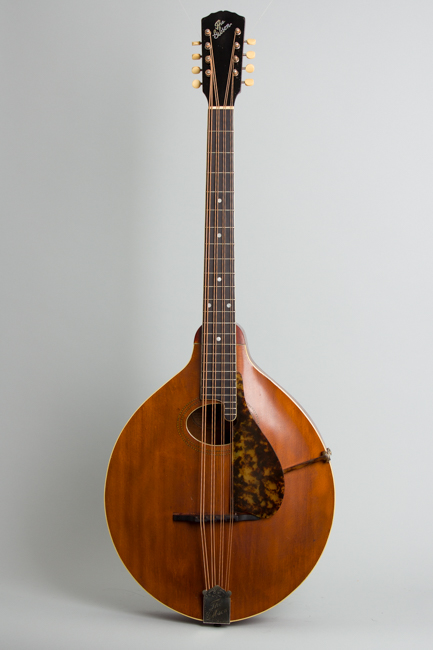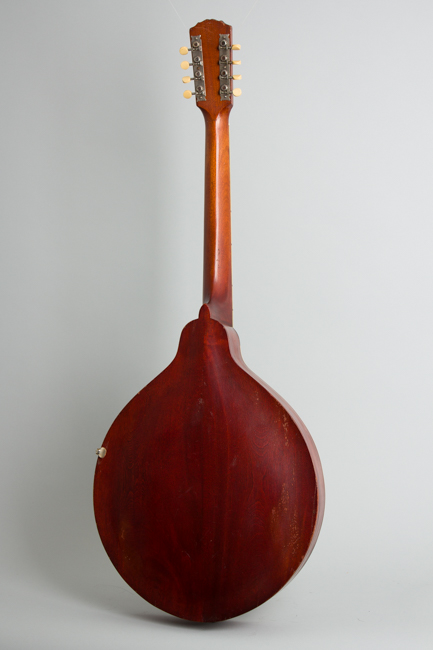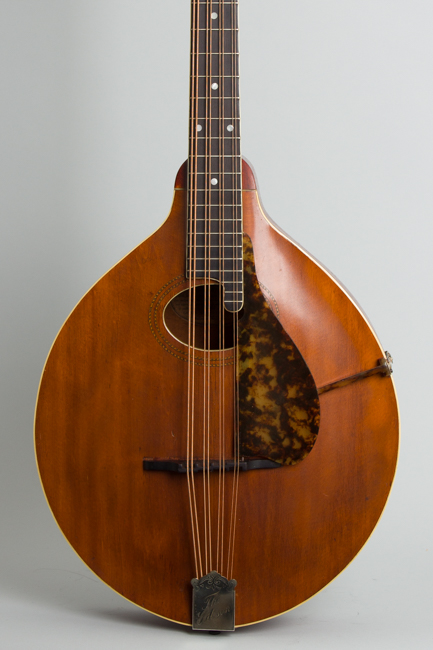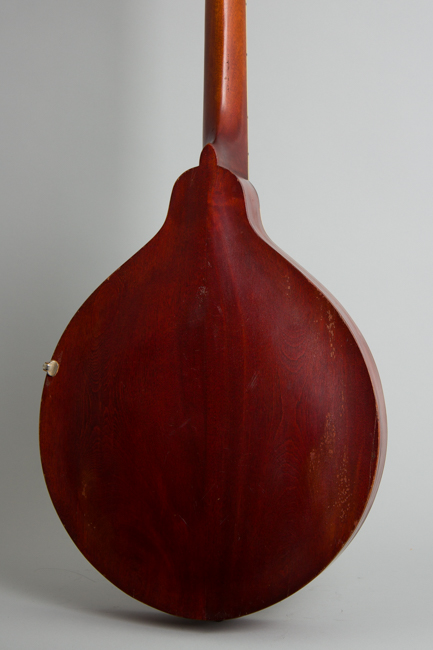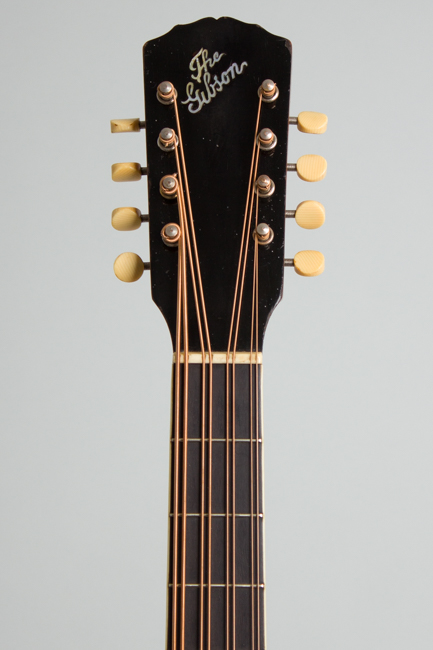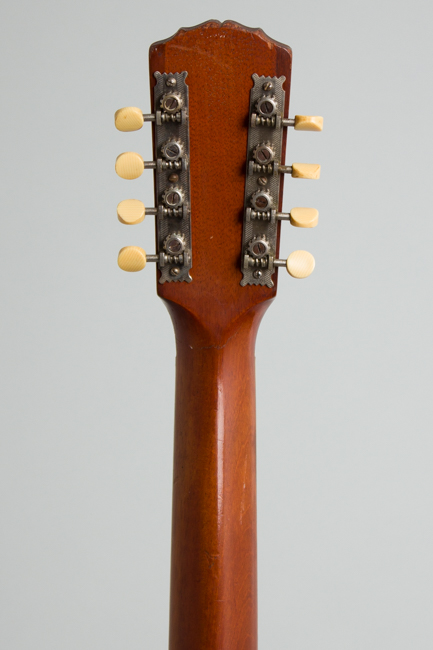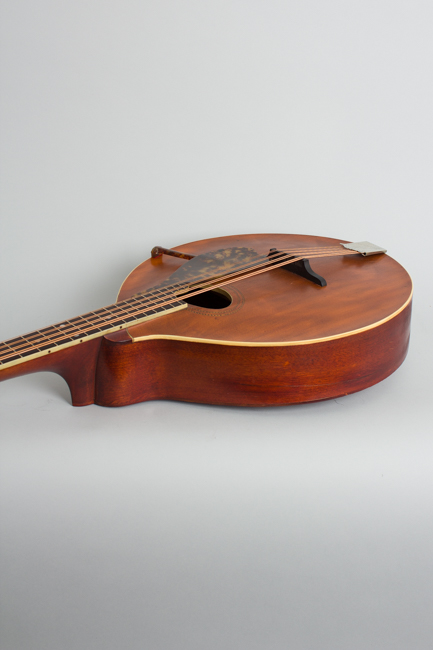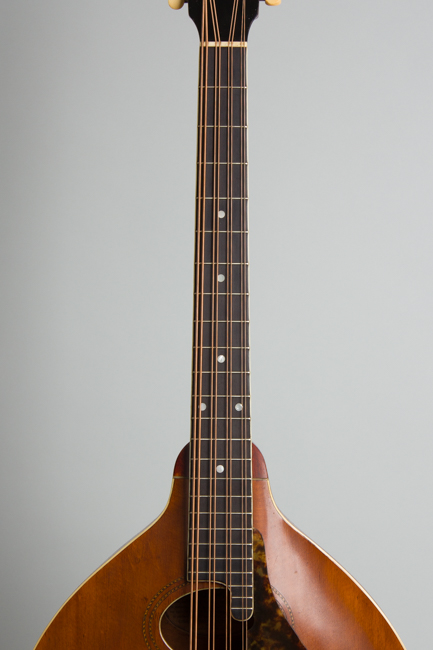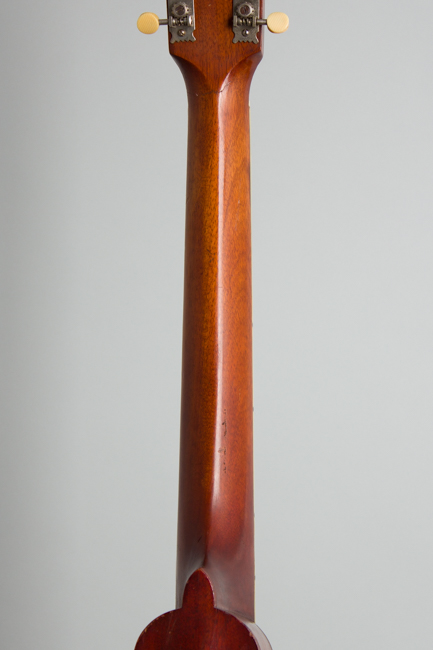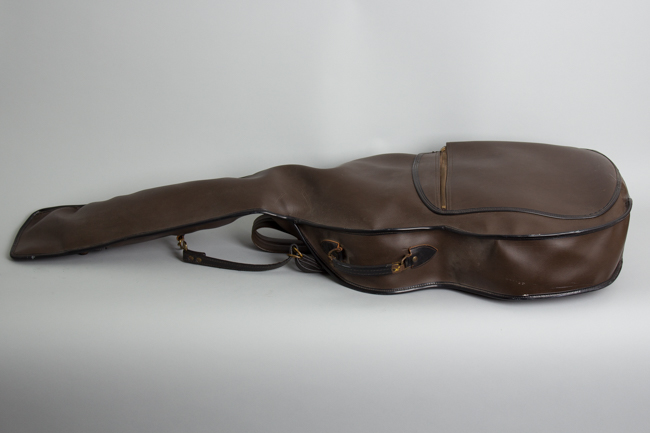Gibson K-1 Carved Top Mandocello (1916)
This item has been sold.
Item # 10283
Prices subject to change without notice.
Gibson K-1 Model Carved Top Mandocello (1916), made in Kalamazoo, Michigan, serial # 36337, natural top, cherry stained back and sides finish, birch back and sides, spruce top; mahogany neck with ebony fingerboard, plastic gig bag case.
We feel the Gibson Mandocello is one of the great under-appreciated instruments of the early 20th century. Originally designed for use in 1910s-era mandolin orchestras, these imposing beasts never found a home in any other style of music despite being wonderful and unique-sounding creations. Double-strung and tuned in fifths starting with the C below the low E on the guitar, the mandocello has an imposing tone and deep resonance quite unlike any other fretted instrument. OK, we're starting to sound like an old Gibson catalog here, but we really like these and are always happy to get one in stock!
This particular instrument is a fairly well worn-in but fantastic sounding Style K-1, the most basic of the three mandocello models Gibson offered in the 1910s but still a fairly expensive instrument when new. It is structurally the same as the fancier Model K-2 with a little less "geegaw" (decoration). The headstock face carries just a plain pearl "The Gibson" inlay while the openback strip tuners are tipped with unadorned ivoroid buttons.
The sound hole decoration is made up of two separate half-herringbone wood inlaid rings and a bound edge. The K-2 had fancier versions of these decorative touches, but the physical features (and sound) were the same for both, with an oval body, bound carved spruce top with a flat oval soundhole and birch back. The necks on all models are mahogany with a bound and dot-inlaid ebony fingerboard.
This 1916 "Pumpkin top" K-1 Mandocello dates to the decade when Gibson was defining the market for these mandolin family instruments. In the 1910s-'20s Gibsons were only available from licensed teacher-agents, and were usually purchased on a time payment plan along with lessons. As part of the deal, the students would often play in the teacher's fretted orchestra, and the low-tuned mandocello was crucial to achieving a full sound in these ensembles. Far fewer were sold compared to mandolins, however, making Gibson mandocellos from any era a comparative rarity.
With its 8 strings and "C" orchestral tuning the mandocello has a totally unique sound and makes an excellent recording instrument. While mandolin orchestras are rather thin on the ground in the 21st century these instruments can be employed for a wide range of playing styles, some still yet to be explored!
Overall length is 38 7/16 in. (97.6 cm.), 14 1/8 in. (35.9 cm.) width, and 3 3/8 in. (8.6 cm.) in depth, measured at side of rim. Scale length is 24 5/8 in. (625 mm.). Width of nut is 1 5/8 in. (41 mm.).
This well-over-100 year old K-1 shows a decent amount of general wear and more than a few repairs; it is far from the cleanest but sonically one of the nicer ones we have had. The original varnish finish has darkened quite a bit over a century and shows noticeable micro-checking, on the top especially but appears completely original. There are dings, dents, scrapes and scratches overall but no large areas of loss except to the worn-through back of the neck.
There are a number of repairs done, some more artfully than others but combined make the instrument structurally solid and very playable. The back/side seams have been visibly re-glued in a number of spots, which it typical for these as the birch backs often have shrunken up noticeably over 100+ years. Some seams were not lined up as cleanly as they might have been, but all are solid. Both the upper and lower sides have fairly obvious old crack repairs; on the lower one extends down from the heelblock, with another over the forward curve of the body and a third off the tailblock. On the bass side one longer split runs about 9" from the outward curve of the body down towards the neck. These are all sealed but not overfinished.
The back has one split just by the upper edge, and a short resealed section of the rear center seam off the bottom edge. The top shows no cracks but has an added brace under the bridge which has done its job well as the arch is very good. This may have been done a long time ago, and the sound seems to have not suffered at all. There is also a very small split at the base of the back of the headstock, just at the apex of the "V". This has been sealed up but not finished over at all so is plainly visible and feelable but not an ongoing issue.
All hardware appears original, including the tuners, tailpiece and cover and even the often missing pickguard and bracket clamp. It is possible the pickguard was once on another mandocello as the fit is inexact around the fingerboard, but it is an authentic period Gibson piece. The one-piece mahogany neck is very straight and original thin frets are in very playable shape, with a comfortable action. Even with this extensive catalog of repairs (or really, because of it) this is an excellent playing and sounding mandocello with a big booming tone. It includes a vintage 1960s heavy guitar gig bag that is a bit oversized but quite functional for storage and carrying. Overall Very Good + Condition.
We feel the Gibson Mandocello is one of the great under-appreciated instruments of the early 20th century. Originally designed for use in 1910s-era mandolin orchestras, these imposing beasts never found a home in any other style of music despite being wonderful and unique-sounding creations. Double-strung and tuned in fifths starting with the C below the low E on the guitar, the mandocello has an imposing tone and deep resonance quite unlike any other fretted instrument. OK, we're starting to sound like an old Gibson catalog here, but we really like these and are always happy to get one in stock!
This particular instrument is a fairly well worn-in but fantastic sounding Style K-1, the most basic of the three mandocello models Gibson offered in the 1910s but still a fairly expensive instrument when new. It is structurally the same as the fancier Model K-2 with a little less "geegaw" (decoration). The headstock face carries just a plain pearl "The Gibson" inlay while the openback strip tuners are tipped with unadorned ivoroid buttons.
The sound hole decoration is made up of two separate half-herringbone wood inlaid rings and a bound edge. The K-2 had fancier versions of these decorative touches, but the physical features (and sound) were the same for both, with an oval body, bound carved spruce top with a flat oval soundhole and birch back. The necks on all models are mahogany with a bound and dot-inlaid ebony fingerboard.
This 1916 "Pumpkin top" K-1 Mandocello dates to the decade when Gibson was defining the market for these mandolin family instruments. In the 1910s-'20s Gibsons were only available from licensed teacher-agents, and were usually purchased on a time payment plan along with lessons. As part of the deal, the students would often play in the teacher's fretted orchestra, and the low-tuned mandocello was crucial to achieving a full sound in these ensembles. Far fewer were sold compared to mandolins, however, making Gibson mandocellos from any era a comparative rarity.
With its 8 strings and "C" orchestral tuning the mandocello has a totally unique sound and makes an excellent recording instrument. While mandolin orchestras are rather thin on the ground in the 21st century these instruments can be employed for a wide range of playing styles, some still yet to be explored!
Overall length is 38 7/16 in. (97.6 cm.), 14 1/8 in. (35.9 cm.) width, and 3 3/8 in. (8.6 cm.) in depth, measured at side of rim. Scale length is 24 5/8 in. (625 mm.). Width of nut is 1 5/8 in. (41 mm.).
This well-over-100 year old K-1 shows a decent amount of general wear and more than a few repairs; it is far from the cleanest but sonically one of the nicer ones we have had. The original varnish finish has darkened quite a bit over a century and shows noticeable micro-checking, on the top especially but appears completely original. There are dings, dents, scrapes and scratches overall but no large areas of loss except to the worn-through back of the neck.
There are a number of repairs done, some more artfully than others but combined make the instrument structurally solid and very playable. The back/side seams have been visibly re-glued in a number of spots, which it typical for these as the birch backs often have shrunken up noticeably over 100+ years. Some seams were not lined up as cleanly as they might have been, but all are solid. Both the upper and lower sides have fairly obvious old crack repairs; on the lower one extends down from the heelblock, with another over the forward curve of the body and a third off the tailblock. On the bass side one longer split runs about 9" from the outward curve of the body down towards the neck. These are all sealed but not overfinished.
The back has one split just by the upper edge, and a short resealed section of the rear center seam off the bottom edge. The top shows no cracks but has an added brace under the bridge which has done its job well as the arch is very good. This may have been done a long time ago, and the sound seems to have not suffered at all. There is also a very small split at the base of the back of the headstock, just at the apex of the "V". This has been sealed up but not finished over at all so is plainly visible and feelable but not an ongoing issue.
All hardware appears original, including the tuners, tailpiece and cover and even the often missing pickguard and bracket clamp. It is possible the pickguard was once on another mandocello as the fit is inexact around the fingerboard, but it is an authentic period Gibson piece. The one-piece mahogany neck is very straight and original thin frets are in very playable shape, with a comfortable action. Even with this extensive catalog of repairs (or really, because of it) this is an excellent playing and sounding mandocello with a big booming tone. It includes a vintage 1960s heavy guitar gig bag that is a bit oversized but quite functional for storage and carrying. Overall Very Good + Condition.
